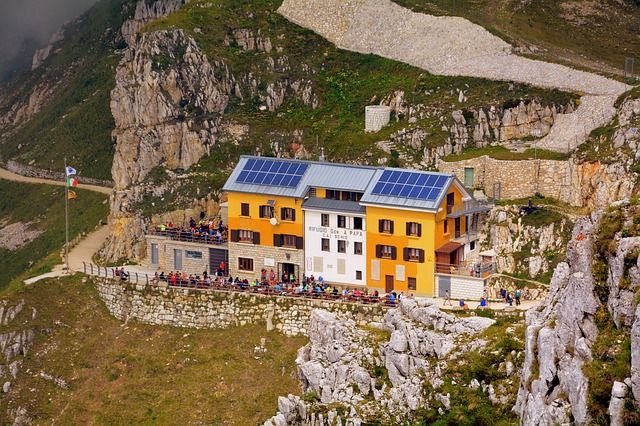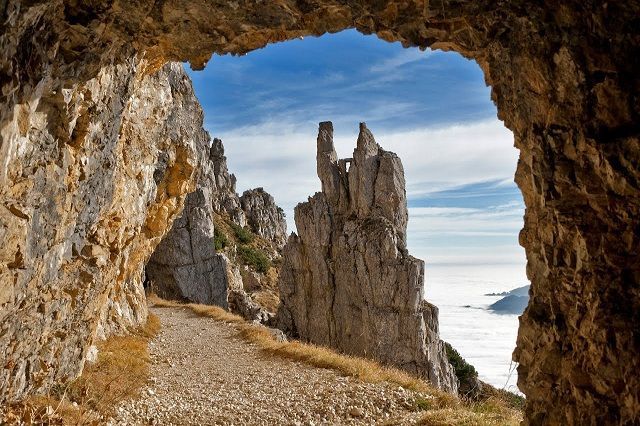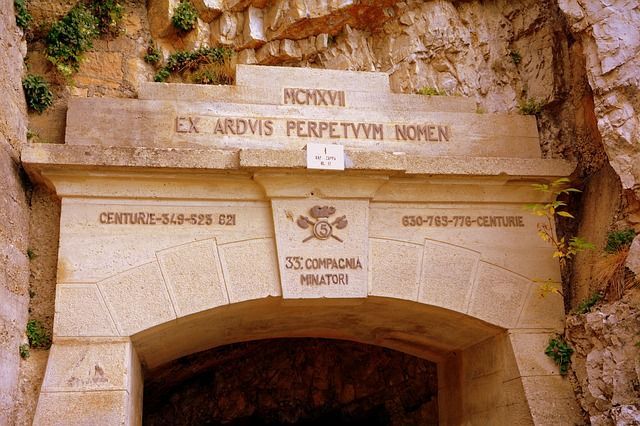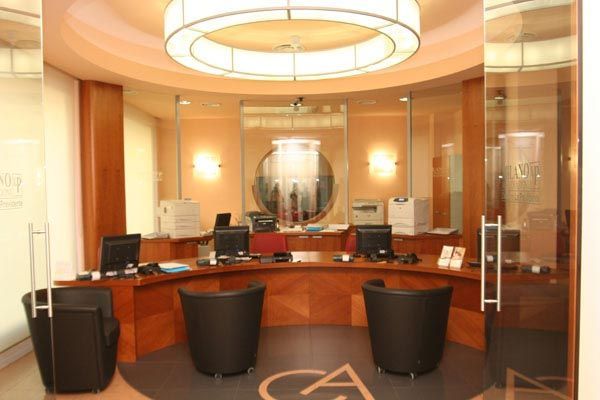WHAT TO VISIT
in Tonezza and surroundings
Some tips on places to visit during your stay at our hotel
Tonezza del Cimone
Tonezza del Cimone (1,000 meters above sea level) boasts one of the most beautiful and captivating landscapes in the Veneto mountains. In autumn, these places are awash with a thousand hues, seemingly lifted from a painter's palette. The hues of the evergreens mingle with those of the yellowing leaves. It's impossible not to be captivated by such seduction, and walking through the woods becomes a moment to free your mind from the hustle and bustle of everyday life. Tonezza is a tranquil mountain village that allows visitors to recharge their spirits by getting close to nature. In town, guests can use the facilities of the Sports Center, which can host camps, retreats, courses, and various events, always surrounded by the surrounding greenery.
Mountain culture
Tonezza also offers a wealth of history and culture. Here in Tonezza, in addition to the nature and Great War trails, you can visit:
- the Ethnographic Museum, a documentation centre of mountain agricultural civilisation;
- the Visitor Centre, which aims to educate and promote the historical heritage of the Great War present on Mount Cimone, in an attempt to promote knowledge and awareness of the changes that occurred in those places during the most dramatic phases of the conflict;
- Tuono Base, located near Passo Coe (1610 m), in the municipality of Folgaria (Trentino), was one of twelve Italian Air Force missile bases deployed in Northern Italy in the 1960s as part of NATO's Southern European air defense system. Its function, like that of the other bases, was to counter potential high-altitude air attacks by Warsaw Pact countries. The weapons system was based on the Nike-Hercules missile, a surface-to-air carrier armed with conventional and nuclear warheads.
Passion for history
Uprooted peaks, blood-stained rocks, machine-gun nests, trenches, rock caverns for gun emplacements, and the remains of permanent fortresses: these are the relics and testimonies that today, even in the "Astico-Posina" sector and the mountain salient that winds from the Pasubio area to the Tonezza and Fiorentini plateau, tell the story of the Great War fought on the Veneto-Trentino front. Then, after the bombings of 1915, it was with the Strafexpedition, launched by the Austro-Hungarians in May 1916, that this contested territory became the last frontier to prevent the enemy from breaking out into the Vicenza plain. Attacks and counterattacks, destroyed villages, lost lives: these were the effects of a war that remained, for its protagonists and witnesses, unforgettable.
read more...
Then, when silence once again reigned supreme over the high pastures and hillsides, and over the peaks lost in the sky, some people erected votive memorials with conviction, renouncing further wars. Meanwhile, mourning for the victims, often nameless, was expressed by lovingly burying the fallen, all brothers in death. Opposite the "Emperor's Fortresses" (Doss del Sommo, Sommo Alto, Cherle, Belvedere, Luserna, Verle, Pizzo di Vezzena) stood "The Sentinels of the Kingdom," namely the Italian forts of Campomolon, Cornolò, Casa Ratti, Punta Corbin, Campolongo, and Verena. For those who wish to walk the paths of history, which include the old western Italian front and, in particular, the pre-Alpine mountains overlooking the Astico and Posina valleys, it is still possible to stumble upon the ruins of these heavily damaged military structures, often destroyed by heavy artillery or blown up during the tragic days of the Strafexpedition. And while today only a few remnants of walls remain of Cornolò, nestled between the Posina and Rio Freddo valleys, protecting Arsiero, a visit to the ruins of Forte Campomolon, located at 1,853 meters above sea level to counter the fortresses of Folgaria, allows one to appreciate the architectural grandeur of its structures, allowing a glimpse, in the battery block, of the series of four armored domes. Further down, in the middle Astico Valley, at an altitude of 350 meters, amid increasingly lush and wild vegetation, one can glimpse the remains of Fort "Casa Ratti." Once equipped with three revolving cupolas and armed with three 149G cast-iron cannons and five machine guns, it is overlooked by the rocky ridge of the Tonezza Plateau. From the mountain village, one climbs to Mount Cimone, a sacred site. The broadleaf forests do not entirely conceal the ancient walkways, trenches, or the complex network of tunnels. The crater, carved by the Austrian mine that exploded on September 23, 1916, is surmounted by the bold spire of the ossuary that watches over the sleep of many fallen soldiers. The gaze sweeps towards horizons where the war is only a memory: the ducal horn of Caviojo and the Neutra peak, with its characteristic helical tunnel, the majestic Priaforà, with its rock caves, seem to watch over the world of the valleys, dotted with villages and districts where time has not stopped, breaking the plots and stories of our history, to be rediscovered with memory, never with myth.
The road of the 52 tunnels of Pasubio
An extraordinary feat of military engineering dating back to World War I, it leads from Bocchetta Campiglia (900 m) to the 'Porte del Pasubio' (1935 m) (General Achille Papa refuge). It allowed the troops entrenched on Pasubio to be supplied with supplies via a very daring route, sheltered from enemy attack. It can be easily covered in 2.5-3.5 hours (6.3 km, including 2.3 km of tunnels). The difference in altitude is approximately 900 meters, and the tunnels are very daring (the 19th is the longest, approximately 320 m, and spirals around itself), with some curves and forks. A reliable flashlight is essential. It is a highly satisfying excursion, a historic route that all hiking enthusiasts, and especially those interested in history, should try at least once, as there is no similar trail anywhere else in Italy. It's impossible not to feel on your skin, in your heart, and in your soul the voices, the calls, the sounds, the thunders that come from the earth, the mountains, the canals, the ravines, the caves, the trenches, the walkways, from every stone, every blade of grass, from everything you see and touch. How can your heart not perceive the torment of war, the suffering, the powerful sensations within your soul? An experience that will remain forever engraved in your heart!!!
The Shelter - First Army Road

Where to stay in a strategic location for exploring the Pasubio Tunnels Road?
Upon request, the Bucaneve Tonezza Village Hotel offers a shuttle service to Bocchetta Campiglia: the starting point for taking the path on the Strada delle 52 Gallerie del Pasubio, the most well-known and fascinating excursion in the Venetian Prealps, from a historical, engineering and cultural point of view.
landscaping.
Mount Pasubio

Mount Pasubio (2,232 meters above sea level) stands as a majestic massif between the provinces of Vicenza and Trento: an evocative location and the scene of significant events in Italian history. Thanks to its unique morphology, during World War I it was a strategic outpost of fundamental importance for the security of the Italian front: due to the difficulty of access, daring roads were carved into the rock. In just nine months, the Pasubio 52 Tunnels Trail was created: an extraordinary feat of military engineering, excavated in 1917 and equipped with 52 tunnels.
The path

The Road of the 52 Tunnels of Pasubio is 6.5 km long, of which 2.3 km are divided into tunnels and is identified by the signpost 366.
It takes 2.30/3.30 hours to complete, starting from Bocchetta Campiglia and arriving at the Gen. Achille Papa refuge (1928 m).
The total elevation gain is approximately 900 meters and you pass through tunnels, bends, and forks: it is therefore essential to have a flashlight with you.
Thanks to regional funding for the centenary of the Great War, extraordinary maintenance work was carried out on the road, and the tourist offering was also increased, with specialized guides available to accompany those interested.
The galleries

Characteristic elements of the path, the tunnels are 52 in total and each of them has been assigned a progressive number and a name, placed at each entrance.
The galleries also feature dedications (with the exception of nos. 49 and 50), assigned in 1917 by Captain Picone.
Of all the tunnels, the longest is number 19: approximately 320 metres long and it spirals around itself!
Shuttle service to access the historic routes "Road of the 52 Tunnels" and "Road of Heroes"
Where can I stay in a strategic location for exploring the 52 Tunnels of Pasubio trail?
The Bucaneve Hotel offers a transfer service to Bocchetta Campiglia exclusively for its guests. The service includes a pick-up from the hotel, accessing the Strada delle 52 Gallerie (Road of the 52 Tunnels), and a pick-up in the evening; all without the use of your own vehicle.
Contact us for more information
If you're looking for a holiday rich in nature, culture, and history, contact us.










